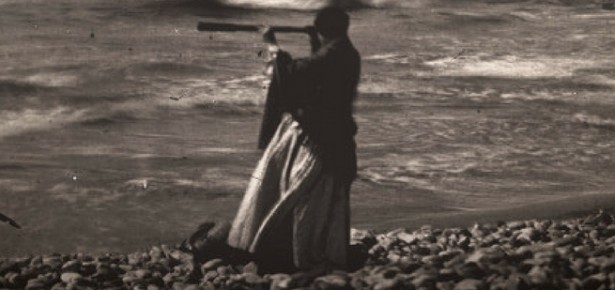
The enigmatic female figure on the cover of Darwin and Women, pointing a telescope at a murky sea, is Thereza Dillwyn Llewelyn, the daughter of the Welsh photographic pioneer John Dillwyn Llewelyn and his wife Emma, also a photographer. Thereza herself experimented with photographic techniques. The scene at Caswell Bay in Wales would have struck contemporaries for its almost instantaneous quality: it had caught waves in motion, and the stirring of Thereza’s dress in the breeze. Such a photograph required good light (it was probably a sunny day, despite appearances), a fast shutter speed, and ideally some easily portable photographic apparatus. Thereza and her father experimented with dry collodion plates, treated with honey and vinegar, which could be kept ready for use for a week, rather than being dipped in vats of chemicals immediately before use.
Thereza exemplifies the lives of many scientific women as part of a family muddle
Thereza exemplifies the lives of many Victorian (and other) scientific women as part of a kind of family muddle – an happy muddle, in Thereza’s case – that supported, obscured, and fragmented their work. John encouraged Thereza’s scientific interests in photography, astronomy, meteorology, and botany. He built her an observatory when she was a teenager (the family was wealthy). They took some of the earliest photographs of the moon; during the long exposure, Thereza slowly moved the telescope by hand to compensate for the earth’s rotation. Her botanical logbook was deposited by George Bentham with the British Association for the Advancement of Science in 1856. Her father did not allow her to attend the association’s annual meeting to present her meteorological work: according to her journal, she was disappointed, but resigned.
Thereza was enviably situated, with access to scientific and progressive society
Thereza married the mineralogist Nevil Story-Maskelyne – they had bonded over photography and astronomy — and started a family almost at once. Nevil was keeper of minerals at the British Museum; they lived in London for many years, and had three daughters. Thereza was enviably situated, with access to scientific and progressive society; she knew Charles Lyell, Charles Babbage, Thomas Huxley, John Tyndall, Florence Nightingale, and Josephine Butler. Yet, in the view of the historian Mary Brück, she did not fulfill her potential in astronomy. She assisted Nevil with his work, cataloguing minerals, and wrote a biography of his grandfather, the astronomer royal Nevil Maskelyne; she continued to work in photography and chemistry with her husband. Their daughters were educated partly at Bedford College for women. Thereza and Nevil moved in much the same circles as Charles Darwin but apparently hadn’t met by 1871, when Nevil used John Lubbock as an intermediary to try to obtain some of Darwin’s botanical papers for Thereza. Apparently as an invalid she found reading and working with a microscope ‘among her most pleasant and refreshing occupations of hours that would otherwise be weary’. She later met Darwin in person (‘she is much better worth knowing than I am’), Nevil joked.
A scientific wife might act as research assistant, secretary, hostess, translator, and networker
At all levels of society, women’s work in support of their husbands was routinely assumed. A wife’s professional aptitude was often a consideration for a prospective husband, particularly one without the resources to employ help. A scientific wife might act as research assistant, secretary, hostess, translator, and networker. Where a couple’s scientific interests converged, such collaboration could provide a woman with opportunities that would otherwise be denied her. Vanda Morton, in her biography of Nevil, writes that he and his friends ‘cared more for their relationships with other thinking people and for the frontiers of scientific discovery’ than they did for public recognition, and that when Nevil was seriously ill after an operation, he exclaimed, ‘I must live, I want to know more about radium’. Maybe Marie and Pierre Curie felt the same way. Yet, despite the attractiveness of the ideal of pure scientific objectivity exemplified in such stories, opportunity does tend to depend on recognition at some level. Thereza was typical of many scientific Victorian women in that her talents were recognised only within a domestic and private social circle: a narrowing that she may have promoted herself and that certainly most of the men around her would have promoted. It was a mould that Marie Curie and other women scientists needed to break.
We are celebrating Marie Curie’s life and legacy on her 150th birthday with a collection of blogs and free content around the theme of Women in STEM.
Check out our content Hub: Marie Curie at 150 – Celebrating Women in STEM
Mary Brück, Women in early British and Irish astronomy: stars and satellites. 2009.
Vanda Morton, Oxford rebels: the life and friends of Nevil Story Maskelyne 1823–1911, pioneer Oxford scientist, photographer and politician. 1987
https://www.darwinproject.ac.uk/letter/DCP-LETT-8091.xml
https://www.darwinproject.ac.uk/letter/DCP-LETT-8100.xml
F. Burkhardt et al., The correspondence of Charles Darwin vol. 22. 2015
Latest Comments
Have your say!